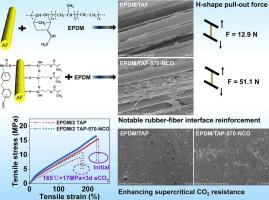Enhancing supercritical CO2 immersion resistance of aramid pulp-filled ethylene propylene diene monomer rubber composites through reinforced interfacial bonding
IF 7.9
2区 材料科学
Q1 MATERIALS SCIENCE, MULTIDISCIPLINARY
引用次数: 0
Abstract
The development of supercritical carbon dioxide(sCO2)-resistant sealing rubbers is a key solution to addressing the critical challenges in the application of sCO2-related industries. This study focused on enhancing the sCO2 immersion resistance of aramid fiber-reinforced ethylene propylene diene monomer (EPDM) rubber composites through strengthened interfacial bonding. Combined modification with coupling agents and polyisocyanate was applied to the surfaces of phosphoric acid-etched aramid fibers. H pull-out tests revealed that after modification, the interfacial bonding strength between the fibers and rubber significantly increased from 12.9 to 51.1 N. Scanning electron microscopy analysis further confirmed this enhanced interfacial bonding. Notably, the modified interface had minimal impact on the high-temperature compression set, thermal aging resistance, thermal decomposition temperature, or low-temperature performance. However, sCO2 immersion tests (165 °C, 17 MPa, 3 days) revealed that interface reinforcement improved the tensile strength retention of EPDM composites containing phosphoric acid-treated aramid fibers modified with coupling agents and polyisocyanate. Specifically, this modification reduced tensile strength loss from 41 % to 33 %. This study provides a simple and effective surface impregnation-based interfacial reinforcement strategy to enhance the sCO2 resistance of rubber composites.

通过增强界面键合增强芳纶浆料填充乙丙二烯单体橡胶复合材料的耐超临界CO2浸泡性能
超临界二氧化碳(sCO2)耐密封橡胶的开发是解决sCO2相关行业应用中关键挑战的关键解决方案。研究了芳纶纤维增强三元乙丙橡胶复合材料通过增强界面键合来提高其抗sCO2浸渍性能。用偶联剂和多异氰酸酯对磷酸刻蚀芳纶纤维表面进行了复合改性。H拉出试验表明,改性后纤维与橡胶之间的界面结合强度从12.9显著提高到51.1 n,扫描电镜分析进一步证实了这种增强的界面结合。值得注意的是,改性界面对高温压缩集、热老化性能、热分解温度和低温性能的影响最小。然而,sCO2浸渍试验(165°C, 17 MPa, 3天)表明,界面增强提高了含有偶联剂和聚异氰酸酯改性的磷酸处理芳纶纤维的EPDM复合材料的抗拉强度保持率。具体来说,这种改性将抗拉强度损失从41%降低到33%。本研究提供了一种简单有效的表面浸渍界面增强策略来增强橡胶复合材料的抗sCO2性能。
本文章由计算机程序翻译,如有差异,请以英文原文为准。
求助全文
约1分钟内获得全文
求助全文
来源期刊

Materials & Design
Engineering-Mechanical Engineering
CiteScore
14.30
自引率
7.10%
发文量
1028
审稿时长
85 days
期刊介绍:
Materials and Design is a multi-disciplinary journal that publishes original research reports, review articles, and express communications. The journal focuses on studying the structure and properties of inorganic and organic materials, advancements in synthesis, processing, characterization, and testing, the design of materials and engineering systems, and their applications in technology. It aims to bring together various aspects of materials science, engineering, physics, and chemistry.
The journal explores themes ranging from materials to design and aims to reveal the connections between natural and artificial materials, as well as experiment and modeling. Manuscripts submitted to Materials and Design should contain elements of discovery and surprise, as they often contribute new insights into the architecture and function of matter.
 求助内容:
求助内容: 应助结果提醒方式:
应助结果提醒方式:


